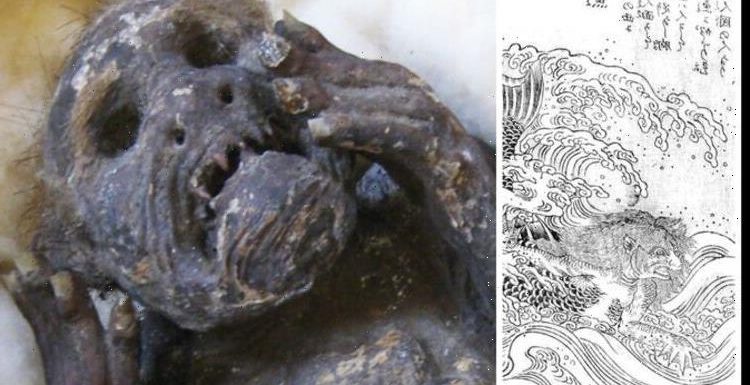
Amanda Holden is underwater mermaid for Seaworld protest
We use your sign-up to provide content in ways you’ve consented to and to improve our understanding of you. This may include adverts from us and 3rd parties based on our understanding. You can unsubscribe at any time. More info
The baby-sized hoax sports a fish-like lower half and a humanoid upper body with thin arms, shark-like teeth set in a grimacing face, and hair on its head and brow. Now held in the Enjuin temple in the city of Asakuchi, fishermen allegedly caught the “mermaid” off the coast of Kochi Prefecture, on Japan’s Shikoku island, between 1736–41. The strange specimen has been taken for CT scanning by researchers from the Kurashiki University of Science and the Arts in Okayama in a bid to unpick the mystery of its origins.
Project leader Hiroshi Kinoshita of the Okayama Folklore Society said the gruesome-looking specimen may have religious significance.
He said: “Japanese mermaids have a legend of immortality. It is said that if you eat the flesh of a mermaid, you will never die.
“There is a legend in many parts of Japan that a woman accidentally ate the flesh of a mermaid and lived for 800 years.
“This legend is also preserved near the temple where the mermaid mummy was found.
“I heard that some people, believing in the legend, used to eat the scales of mermaid mummies.”


A letter stored alongside the mummy — apparently penned by a former owner back in 1903 — claims to tell the story of the fishy creature’s provenance.
It reads: “A mermaid was caught in a fish-catching net in the sea off Kochi Prefecture.”
“The fishermen who caught it did not know it was a mermaid, but took it to Osaka and sold it as an unusual fish. My ancestors bought it and kept it as a family treasure.”
It is unclear at what point the specimen was brought to the Enjuin temple — but, according to chief priest Kozen Kuida, the “mermaid” was put on display in a glass case some 40 years ago, although it has since been transferred into a fireproof safe.
He told The Asahi Shimbun: “We have worshipped it, hoping that it would help alleviate the coronavirus pandemic even if only slightly.”
In Japanese myth, Mr Kinoshita explained, there is a legend in which a mermaid predicted the outbreak of an infectious disease.


While the priests of Enjuin temple may worship the mummified specimen, Mr Kinoshita believes that it was deliberately manufactured at some point during Japan’s Edo period, which spanned from 1603–1867.
He said: “Of course, I don’t think it’s a real mermaid.
“I think this was made for export to Europe […] or for spectacles in Japan.
“The legend of mermaids remains in Europe, China, Japan, and all over the world. Therefore, I can imagine that people at that time were also very interested in it.
“I think it is made from living animals and we would like to identify them by CT scans or DNA testing.
“It looks like a fish with scales on the lower body and a primate with hands and a face on the upper body.”
In fact, in Japanese folklore, a creature called a Ningyo — literally, “human fish” — is described very similarly, having a monkey’s mouth, small teeth like a fish, shining golden scales and a voice like a small bird.
DON’T MISS:
Ancient Egypt breakthrough as body could explain mummification origins [INSIGHT]
New discovery reveals 40,000-year-old culture in China [ANALYSIS]
Archaeologists stunned at tool found near mammoth bones [REPORT]

There is certainly a precedent for such elaborate cryptozoological hoaxes.
P.T. Barnum — the American businessman and circus operator whose life inspired the 2017 film “The Greatest Showman” — exhibited a similar specimen at his “American Museum” in New York from 1842 until the building burnt to the ground in 1865.
This so-called Fiji mermaid, named for the islands near where it was ostensibly caught in the South Pacific, consisted of the mummified torso and head of a juvenile monkey that had been sown onto the tail of a fish.
The specimen went on to inspire a series of similar hoaxes — one of which is on display in the Booth Museum of Natural History in Brighton, England.
The full findings of the fresh examination of the mummy will be published later this year.
Additional reporting by Michael Havis.
Source: Read Full Article